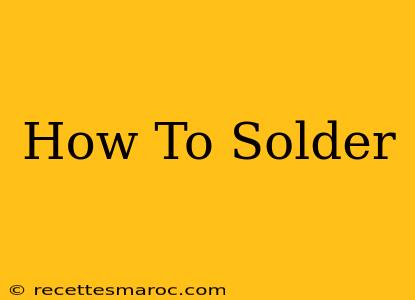Soldering is a fundamental skill for anyone working with electronics, from hobbyists building circuits to professionals repairing devices. This comprehensive guide will walk you through the basics of soldering, covering everything from essential tools and materials to techniques for achieving clean, reliable joints. Whether you're a complete novice or looking to refine your skills, this guide will help you master the art of soldering.
Essential Tools and Materials for Soldering
Before you begin, gather the necessary tools and materials. Investing in quality tools will make the process significantly easier and produce better results. Here's what you'll need:
-
Soldering Iron: Choose an iron with a wattage appropriate for your projects. For beginners, a 25-40W iron is a good starting point. Temperature control is a valuable feature, allowing you to adjust the heat for different types of solder and components.
-
Solder: Select a rosin-core solder with a diameter of around 0.8mm to 1.0mm. Rosin core solder contains flux, which cleans the metal surfaces and aids in the soldering process. Avoid acid-core solder, as it can corrode your components.
-
Solder Sucker/Desoldering Braid: These tools are crucial for removing excess solder or correcting mistakes. A solder sucker is a small pump that removes solder, while desoldering braid (also known as wick) absorbs solder.
-
Helping Hands/Third Hand: This tool holds your work in place, freeing up both hands for soldering.
-
Soldering Iron Stand: This provides a safe and convenient place to rest your hot soldering iron.
-
Sponges or Cleaning Cloth: Keep a damp sponge or cloth handy to wipe the tip of your soldering iron clean.
-
Safety Glasses: Always protect your eyes with safety glasses.
-
Heat-Resistant Mat: Protect your work surface from heat damage.
Preparing for the Soldering Process
Proper preparation is essential for successful soldering. Here are some crucial steps:
-
Cleanliness: Ensure your work area is clean and organized. Any dust or debris can interfere with the soldering process.
-
Tinning the Tip: Before you start, "tin" the tip of your soldering iron. This involves applying a thin coat of solder to the tip, ensuring good heat transfer and preventing oxidation.
-
Clean the Components: Clean the surfaces of the components you'll be soldering using isopropyl alcohol. This removes any oxidation or residue, leading to stronger solder joints.
Soldering Techniques: A Step-by-Step Guide
Now, let's delve into the actual soldering process:
-
Heat the joint: Apply the tip of your soldering iron to the joint between the components, making sure both parts are heated equally. This helps ensure the solder flows evenly.
-
Apply the solder: Touch the solder to the joint near the soldering iron tip, not directly onto the iron itself. The heat from the joint will melt the solder, allowing it to flow into the connection and form a strong bond.
-
Remove the iron: Once the solder has flowed smoothly and created a nice, shiny, concave (not convex!) fillet, remove the soldering iron. Avoid moving the components while the solder cools.
-
Inspect the joint: Check that the solder has created a good connection and is neatly formed. A good solder joint should be shiny and smooth, and fully cover the connection without being excessive. Avoid “cold” solder joints, characterized by dull, gray, and rough appearance.
Troubleshooting Common Soldering Problems
-
Cold Joints: These occur when the solder doesn't properly fuse with the components. This is usually due to insufficient heat or unclean surfaces.
-
Excess Solder: Too much solder can create a messy joint and can short-circuit components.
-
Solder Bridges: These occur when solder unintentionally connects two adjacent components. Careful application and use of a helping hand can help prevent this.
Advanced Soldering Techniques
As you gain experience, you can explore more advanced techniques, such as:
-
Surface Mount Device (SMD) Soldering: SMD soldering requires more precision and specialized tools.
-
Through-Hole Soldering: This method is generally easier to learn and involves soldering components with leads that go through the circuit board.
Mastering soldering is a gradual process. Practice is key to developing your skills and confidence. Start with simple projects and gradually increase the complexity as your abilities improve. Remember safety first! Always use appropriate safety gear and take your time. With patience and practice, you'll be soldering like a pro in no time!

